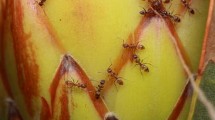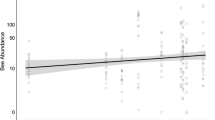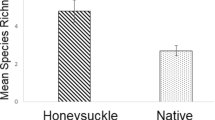Abstract
Ants are extensive users of arboreal sugars, but little is known about how ecological dominance or habitat succession influences this interaction. We investigated how the availability and use of arboreal sugar resources by ants changes across a restoration chronosequence. We surveyed the use and availability of hemipteran honeydew and floral nectar on the two dominant plant genera, Eucalyptus and Acacia, in study sites in south eastern Australia. Sugars used by ants are likely to drive their role as ecosystem engineers, while sugars not used by ants remain available to other organisms. We also tested whether the use of sugars differed between ecologically dominant and non-dominant ants; taxa likely to perform different functions in ecosystems. No floral nectar was available on Acacia, but later successional eucalypts supported more floral resources and fewer mutualist hemiptera. Successional stage significantly affected how much sugar remained unexploited by ants, with similar trends for ant use of sugars. Non-dominant ants used mainly floral nectar, while hemipteran honeydew resources were used disproportionately by dominant ants, consistent with the prediction that this group monopolises persistent carbohydrate resources. This pattern was similar across successional stages, but the difference was least in habitats with the greatest availability of floral nectar, suggesting that high sugar availability may reduce the incentive to defend honeydew. Across habitat types, the proportion of dominant ants increased with the availability of hemipteran honeydew. This suggests that honeydew availability may regulate ecological dominance, thus affecting ant-driven ecosystem processes.



Similar content being viewed by others
References
Andersen A.N. 1990. The use of ant communities to evaluate change in Australian terrestrial ecosystems: a review and a recipe. Proc. Ecol. Soc. Aus. 16: 347–357
Andersen A.N. and Morrison S.C. 1998. Myrmecochory in Australia’s seasonal tropics: Effects of disturbance on distance dispersal. Aust. J. Ecol. 23: 483–491
Beggs J.R., Karl B.J., Wardle D.A. and Bonner K.I. 2005. Soluble carbon production by honeydew scale insects in a New Zealand beech forest. N.Z. J. Ecol. 29: 105–115
Birtchnell M.J. and Gibson M. 2006. Long-term flowering patterns of melliferous Eucalyptus (Myrtaceae) species. Aust. J. Bot. 54: 745–754
Blüthgen N., Verhaagh M., Goitia W., Jaffe K., Morawetz W. and Barthlott W. 2000. How plants shape the ant community in the Amazonian rainforest canopy: the key role of extrafloral nectaries and homopteran honeydew. Oecologia 125: 229–240
Blüthgen N. and Fiedler K. 2004. Competition for composition: lessons from nectar-feeding ant communities. Ecology 85: 1479–1485
Blüthgen N., Gottsberger G. and Fiedler K. 2004. Sugar and amino acid composition of ant-attended nectar and honeydew sources from an Australian rainforest. Aust. Ecol. 29: 418–429
Brooker M.I.H, Slee A.V., Connors J.R. and Duffy S.M. 2002. Euclid: Eucalypts of Southern Australia. CSIRO Publishing, Collingwood, Victoria, Australia
Cornelissen T, Wilson Fernandes G and Vasconcellos-Neto J 2008. Size does matter: Variation in herbivory between and within plants and the plant vigour hypothesis. Oikos 117: 1121–1130
CSIRO 1996. The Insects of Australia. Melbourne University Press, Carlton, Victoria. 1137 pp
Davidson D.W. 1998. Resource discovery versus resource domination in ants: a functional mechanism for breaking the trade-off. Ecol. Entomol. 23: 484–490
Davidson D.W. 1997. The role of resource imbalances in the evolutionary ecology of tropical arboreal ants. Biol. J. Linn. Soc. 61: 153–181
Davidson D.W., Cook S.C., Snelling R.R. and Chua T.H. 2003. Explaining the abundance of ants in lowland tropical rainforest canopies. Science 300: 969–972
Davis A.R. 1997. Influence of floral visitation on nectar-sugar composition and nectary surface changes in Eucalyptus. Apidologie 28: 27–42
Dejean A., Bourgoin T. and Gibernau M. 1997. Ant species that protect figs against other ants: Result of territoriality induced by a mutualistic homopteran. Ecoscience 4: 446–453
Eastwood R. and Fraser A.M. 1999. Associations between lycaenid butterflies and ants in Australia. Aust. J. Ecol. 24: 503–537
Eisner T. 1957. A comparative morphological study of the proventriculus of ants. Hymenoptera: Formicidae. Bull. Mus. Comp. Zool. 116: 429–490
Folgarait P.J. 1998. Ant biodiversity and its relationship to ecosystem functioning: a review. Biodiv. Conserv. 7: 1221–1244
Flatt T. and Weisser W.W. 2000. The effects of mutualistic ants on aphid life history traits. Ecology 81: 3522–3529
Gibb H. 2005. The effect of a dominant ant, Iridomyrmex purpureus, on resource use by ant assemblages depends on microhabitat and resource type. Austral Ecology 30: 856–867
Gibb H. and Hochuli D.F. 2004. Removal experiment reveals limited effects of a behaviorally dominant species on ant assemblages. Ecology 85: 648–657
Goldberg J.L., Grant J.W.A. and Lefebvre L. 2001. Effects of the temporal predictability and spatial clumping of food on the intensity of competitive aggression in the Zenaida dove. Behav. Ecol. 12: 490–495
Gove A.D., Majer J.D. and Dunn R.R. 2007. A keystone ant species promotes seed dispersal in a “diffuse” mutualism. Oecologia 153: 687–697
Grant J.W.A. and Guha R.T. 1993. Spatial clumping of food increases its monopolization and defense by convict cichlids, Cichlasoma nigrofasciatum. Behav. Ecol. 4: 293–296
Grover C.D., Kay A.D., Monson J.A., Marsh T.C. and Holway D.A. 2007. Linking nutrition and behavioural dominance: carbohydrate scarcity limits aggression and activity in Argentine ants. Proc. R. Soc. B. 274: 2951–2957
Hoffmann B.D. and Andersen A.N. 2003. Responses of ants to disturbance in Australia, with particular reference to functional groups. Austral Ecol. 28: 444–464
Holway D.A., Lach L., Suarez A.V., Tsutsui N.D. and Case T.J. 2002. The causes and consequences of ant invasions. Annu. Rev. Ecol. Syst. 33: 181–233
Huberty A.F. and Denno R.F. 2004. Plant water stress and its consequences for herbivorous insects - a new synthesis. Ecology 85: 1383–1398
Jonasson S., Michelsen A., Schmidt I.K., Nielsen E.V. and Callaghan T.V. 1996. Microbial biomass C N and P in two Arctic soils and responses to addition of NPK fertilizer and sugar: Implications for plant nutrient uptake. Oecologia 106: 507–515
Kelly D. 1990. Honeydew density in mixed Nothofagus forest, Westland, New Zealand. N.Z. J. Bot. 28: 53–58
Kenrick J. 2003. Review of pollen-pistil interactions and their relevance to reproductive biology of Acacia. Aust. Syst. Bot. 16: 119–130
Lach L. 2003. Invasive ants: Unwanted partners in ant-plant interactions? Ann. Missouri Bot. Gardens 90: 91–108
Law B.S. and Chidel M. 2008 Quantifying the canopy nectar resource and the impact of logging and climate in spotted gum Corymbia maculata forests. Aust. Ecol. 33: 999–1014
Maslin B.R. 2001. Wattle: Acacias of Australia. CSIRO Publishing, Collingwood, Victoria, Australia
Michalzik B., Müller T. and Stadler B. 1999. Aphids on Norway spruce and their effects on forest-floor solution chemistry. For. Ecol. Manage. 118: 1–10
Ness J.H. and Bronstein I.L. 2004. The effects of invasive ants on prospective ant mutualists. Biol. Inv. 6: 445–461
Orians G.H. and Milewski A.V. 2007. Ecology of Australia: The effects of nutrient-poor soils and intense fires. Biol. Rev. 82: 393–423
Parr C.L., Andersen A.N., Chastagnol C. and Duffaud C. 2007. Savanna fires increase rates and distances of seed dispersal by ants. Oecologia 151: 33–41
Payne R.W., Murray D.A., Harding S.A., Baird D.B. and Soutar D.M. 2007. GenStat for Windows. 10 th Edition: Introduction. VSN International, Hemel Hempstead.
Pimm S.L. 1978. An experimental approach to the effects of predictability on community structure. Am. Zool. 18: 797–808
Price P.W. 1991. The plant vigor hypothesis and herbivore attack. Oikos 62: 244–251
PRIMER-E Ltd 2002. PRIMER for Windows, Version 529
Room P.M. 1975. Relative distributions of ant species in cocoa plantations in Papua New Guinea. J. Appl. Ecol. 12: 47–61
SAS Institute (2007) JMP. SAS Institute INC, Cary, N.C.
Schemske D.W. 1982. Ecological correlates of a neotropical mutualism: ant assemblages at Costus extrafloral nectaries. Ecology 63: 932–941
Sedgley M. 1989. Acacia. In: Handbook of Flowering (Halevy A H., Ed), CRC Press. 753 pp
Seeger J. and Filser J. 2008. Bottom-up down from the top: Honeydew as a carbon. source for soil organisms. Eur. J. Soil Biol. 44: 483–490
Shattuck S.O. 1999. Australian Ants: Their Biology and Identification. CSIRO Publishing, Australia. 226 pp
Stadler B. and Dixon A.F.G. 2005. Ecology and evolution of aphid–ant interactions. Annu. Rev. Ecol. Evol. Syst. 36: 345–372
Stadler B. and Michalzik B. 1998. Linking aphid honeydew throughfall and forest floor solution chemistry of Norway spruce. Ecol. Lett. 1: 13–16
Stadler B., Michalzik B. and Müller T. 1998. Linking aphid ecology with nutrient fluxes in a coniferous forest. Ecology 79: 1514–1525
Stadler B., Solinger S. and Michalzik B. 2001. Insect herbivores and the nutrient flow from the canopy to the soil in coniferous and deciduous forests. Oecologia 126: 104–113
Stafford Smith D.M. and Morton S.R. 1990. A framework for the ecology of arid Australia. J. Arid Env. 18: 255–278
Stone G.N., Raine N.E., Prescott M. and Wilmer P.G. 2003. Pollination ecology of acacias (Fabaceae, Mimosoideae). Aust. Syst. Bot. 16: 103–118
Styrsky J.D. and Eubanks M.D. 2007. Ecological consequences of interactions between ants and honeydew-producing insects. Proc. R. Soc. B 274: 151–164
Way M.J. 1958. The influence of other ant species on biological control of Oecophylla longinoda. Latr. Proc. X Int. Congr. Entomol. 4: 595–596
Way M.J. 1963. Mutualism between ants and honeydew-producing Homoptera. Annu. Rev. Entomol. 8: 307–344
Yao I. and Akimoto S. 2001. Ant attendance changes the sugar composition of the honeydew of the drepanosiphid aphid Tuberculatus quercicola. Oecologia 128: 36–43
Acknowledgments
We thank Natalie Banks, Kim Pullen, Eliza Finlay and Lym Garrett for their invaluable help with field work and Alan Andersen for helpful comments on the manuscript. Greening Australia helpfully provided us with a range of useful contacts. We are grateful to the farmers of Murrumbateman, Bungendore and Boorowa, who kindly allowed us to study insects on their land.
Author information
Authors and Affiliations
Corresponding author
Rights and permissions
About this article
Cite this article
Gibb, H., Cunningham, S.A. Does the availability of arboreal honeydew determine the prevalence of ecologically dominant ants in restored habitats?. Insect. Soc. 56, 405–412 (2009). https://doi.org/10.1007/s00040-009-0038-9
Received:
Revised:
Accepted:
Published:
Issue Date:
DOI: https://doi.org/10.1007/s00040-009-0038-9




